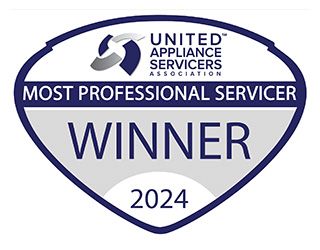The Truth about Green Appliances
 Is it time to replace my appliances with more energy-efficient models?
Is it time to replace my appliances with more energy-efficient models?
As more and more people weigh the environmental impact of the products they buy, more and more companies scramble to appear “green” to win their business. Of course, not all companies are willing to invest in actually being green—they slap some vague eco-friendly messaging on their packaging and call it a day, assuming that ignorant buyers will fall for it. It’s a practice called greenwashing, and yeah, it’s terrible.
Today, your Hometown Heroes will help you make sense of the environmental impact of your home appliances so you can make eco-friendly decisions when buying new appliances.
Does it really matter if my appliances are “green” or not?
First things first: it absolutely matters if your appliances are energy and water efficient. Yes, reducing your individual carbon footprint will not stop climate change, that narrative came about because big business didn’t want the buck to stop with them. And yes, exerting public pressure on companies and governments is still your best option for making a difference. But we should hold ourselves responsible for the emissions we can control, and by some estimates, your appliances account for 13% of your household energy usage.
13% may not seem like a lot, so allow us to put that in perspective. The average US household consumes about 10,715 kilowatt-hours (kWh) per year, and the rule of thumb is that every kWh results in about a pound of carbon emissions (CO2e). Do the math and your appliances produce around 1,330 lb of CO2e every year, the equivalent of burning 667 lb of coal.
And there’s a wide range in the efficiency of individual appliances. The average refrigerator has between 20-23 cubic feet of storage that must be kept cold 24/7 for up to 20 years. Among EnergyStar Certified refrigerators, the least efficient has an annual energy use of 716 kilowatt-hours per year (kWh/yr) and the most efficient an annual energy use of 260 kWh/yr. Thus, over a 20-year lifespan, the most efficient EnergyStar refrigerator will generate 8,710 fewer pounds of CO2e than the least efficient EnergyStar refrigerator (or the equivalent of 4,371 lb of coal).
Clearly, efficiency makes a difference. And that’s not even taking into account the non-EnergyStar Certified refrigerators on the market, which still meet the federal minimum standards for efficiency but are on average 9% less efficient. Neither does it take into account how much energy efficiency has improved year by year for the past half-century. 40 years ago, we owned smaller refrigerators that still used a whopping 1,700 kWh/yr! Compared to a 1982 refrigerator, the CO2e you avoid with a modern refrigerator could power an entire home for a year and a half!
For the environmental benefits, for the money you save, for your own peace of mind, energy efficiency is worth investing in. And the more American households that invest in energy efficient appliances, the bigger the impact we can collectively make towards reducing emissions.
So should I go out and buy more energy efficient appliances today?
Ah, see, that’s where things get more complicated. Some articles make it sound like common sense to go out and buy new appliances to reduce your energy bill and carbon footprint. But refrigerators don’t just appear out of thin air at your nearest big box store. The raw materials must be extracted and refined, transported to and from manufacturing facilities (not all refrigerator components are produced in a single factory), assembled and packaged, and only then transported to your local appliance store.
It sounds like a lot, and it is: estimates of the emissions from extraction to sale suggest the average refrigerator requires nearly 1,000 lb of CO2e to produce. It takes fewer emissions to manufacture your other home appliances, though they have shorter lifespans and consume less energy per year. So no, replacing every appliance you own with a newer model likely won’t help the environment. That said, you’ll notice the emissions to manufacture a refrigerator is far less than the lifetime energy usage of a refrigerator in your home, which means there is a point at which replacing your old appliances with newer models becomes a net gain for the world.
The trick is figuring out when you’ve reached that point. It’s easy to find energy efficiency information for appliances you are considering buying, but not so easy to find energy efficiency information for the appliance in your home. You could go out and buy a Kill A Watt electricity usage monitor, plug your appliances in, and do the math, or you can follow this simple rule of thumb: as an appliance nears the end of its average lifespan, the emissions math is now in your favor to replace it.
AVERAGE LIFESPANS
- Range / Ovens = 15 years
- Dryers = 14 years
- Refrigerator = 13 years
- Washers = 12 years
- Dishwashers = 9 years
Note: higher quality appliances typically have a higher manufacturing cost, but are often more energy efficient and last longer, so for them, tack on 3-5 years to the lifespans above.
What’s a green way to dispose of my refrigerator?
Appliances are big and picturing landfills full of them is a sobering thought. Luckily, according to Whirlpool, “up to 90 percent of the materials used in an appliance are fully recyclable and […] of high value, which makes recycling them profitable.” But though Whirlpool and other manufacturers talk a big game about recycling programs, there are very few systems in place to ensure old appliances are upcycled into new appliances. Don’t worry though, they aren’t lying about the value of old appliances.
Many dealers actually resell used appliances, extending their lifespan, though they often ship them to other stores (possibly in other states) to do that. There is also a thriving scrap metal trade around breaking down appliances and selling off the raw materials. The folks who install your new appliance (and haul away the old one) may do it, or your local waste management company, or just enterprising folks hustling for a little extra cash. So rest assured, very few appliances end up in a dump.
If you are considering extending the lifespan of your refrigerator by converting it into a basement or garage refrigerator, you will only double your energy usage, pushing the math out of your favor. While it is better for the environment and your budget to invest in less refrigerator space (see below for more on this), if you do require more refrigeration space, either (a) invest in a larger refrigerator to replace your old one, or (b) invest in a small cooler or freezer to complement your new refrigerator, whether unattached in your basement or as an undercounter addition in your kitchen.
Want a few eco-friendly buying tips?
Buy a high-quality appliance.
If the appliance you’re going to buy will be in your home for over a decade before its replaced, why not make it an appliance you’ll love? High-efficiency and high-quality typically go hand-in-hand, so there will be less of a gap between your appliance and newer models on the market as the years pass. And it should break down less often and last longer, putting you in fewer repair-or-replace conundrums.
Buy American.
Products manufactured in the US have typically traveled less far to make it to your local appliance store, and despite our overall environmental record, the US does have laws and regulations in place to limit manufacturing emissions and manage the byproducts.
Buy “right-sized” refrigerators.
Every cubic foot of fridge space is another cubic foot that needs to be cooled down 24/7, so a small refrigerator full of food is thus more efficient than a bigger refrigerator with unused space. Rule of thumb is we need 4-6 cubic feet of space per person in a household, so buy accordingly. A smaller refrigerator will also cost you less and encourage you to buy and waste less food.
Use cold wash cycles.
Heating up water for showers and wash cycles is one of the biggest energy draws in your house, but the truth is, you don’t need to wash your laundry in hot water. Preset cold wash cycles and cold water detergents exist because they work. In fact, unless you are dealing with serious stains, hot water doesn’t clean all that much better, but it does wear out your clothes faster. It’s also worth noting, front-load washers use less water than top-load washers by moving clothes through water, instead of water through the clothes.
Also, be sure to check out our appliance buying guides for refrigerators, ovens and ranges, dishwashers, and washers and dryers.









